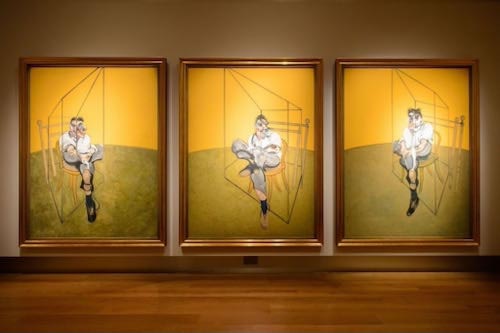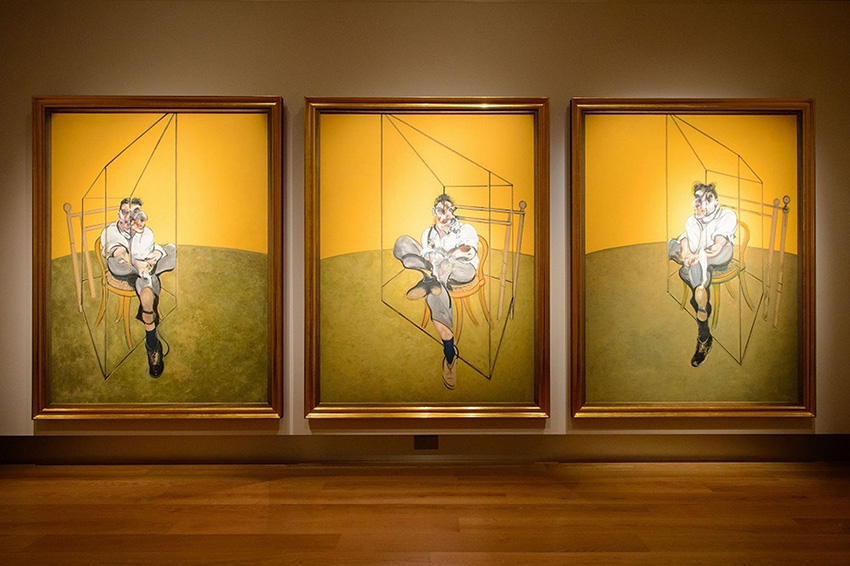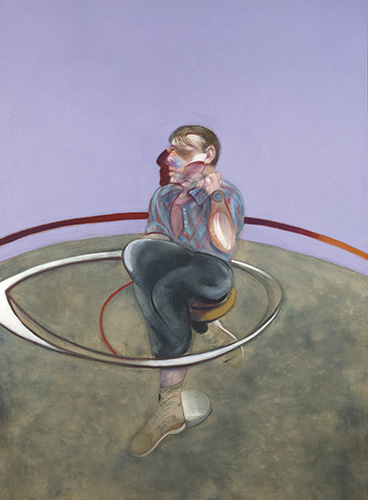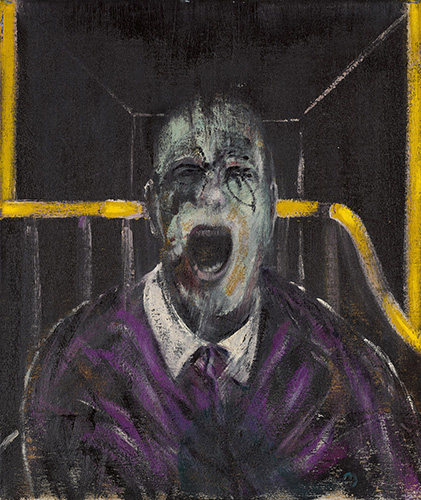
The famous grotesque paintings of Francis Bacon...
ArtWizard, 16.09.2019
"I would like my picture to look as if a human being had passed between them, like a snail leaving its trail of the human presence... as a snail leaves its slime."
Francis Bacon
Born in Dublin, Francis Bacon was named after his famous ancestor, the English philosopher and scientist. His father, Edward, served in the army and later took a job in the War Office during World War I. In an interview with critic David Sylvester, Bacon attributed the connotations of violence in his paintings to the turbulent circumstances of his early life. His father's position in the War Office alerted him to the threat of violence at an early age. Returning to Dublin after the war, he came of age amidst the early campaigns of the Irish nationalist movement.

Francis Bacon, Figure at a wash basin from, 1976
Francis Bacon produced some of the most iconic images of wounded and traumatized humanity in post-war art. Borrowing inspiration from Surrealism, film, photography, and the Old Masters, he forged a distinctive style that made him one of the most widely recognized exponents of figurative art in the 1940s and 1950s. Bacon concentrated his energies on portraiture, often depicting habitues of the bars and clubs of London's Soho neighborhood. His subjects were always portrayed as violently distorted, almost slabs of raw meat, that are isolated souls imprisoned and tormented by existential dilemmas. One of the most successful British painters of the 20th century, Bacon's reputation was elevated further during the "art world's" widespread return to painting in the 1980s, and after his death he became regarded by some as one of the world's most important painters.
Many consider that Bacon’s art was largely influenced by his private life. In the beginnings of the 1960s, Bacon met George Dyer with whom he had fallen in love. Infatuated, Bacon chose Dyer as a recurrent subject of his works in the 1960s. The death of his lover led to the different approach by Bacon, that would eventually lead to the more reductive artistic approach, which culminated during the 1980s. There are many of his paintings that were sold for huge amounts of money.
It was November 12, 2013, when one of the Francis Bacon paintings was sold at auction in New York, setting the world record as the most expensive piece of art sold at auction, when Bacon became a star. This a bit unexpected sale broke all the records and put Francis Bacon at the list of the most popular contemporary artists of our era. It took seven superrich bidders to propel a 1969 Francis Bacon "Triptych" to USD 142.4 million at Christie’s, making it the most expensive work of art ever sold at auction. William Acquavella, the New York dealer, is thought to have bought the painting on behalf of an unidentified client, from one of Christie’s skyboxes overlooking the auction.

Francis Bacon, Triptych Three Studies of Lucian Freud, 1969
The price for the painting, which depicts Lucian Freud, Bacon’s friend and rival, perched on a wooden chair, was more than the USD 85 million Christie’s had estimated. It also toppled the previous record set in May 2012 when Edvard Munch’s fabled pastel of “The Scream” sold at Sotheby’s for USD119.9 million and broke the previous record for the artist at auction set at the peak of the market in May 2008, when Sotheby’s sold a triptych from 1976 to the Russian oligarch Roman Abramovich for USD 86.2 million.
Another painting of Francis Bacon was sold also vey expensive - the “Self Portrait “, 1978 is not the only a self-portrait by Francis Bacon, but a very significant artwork since it was created during the recovery from depression caused by the death of the artist’s lover George Dyer in 1971. It shows the artist dressed in boots and an unbuttoned shirt in a lavender room. The piece was put on sale in 2007, at Sotheby’s London, with estimated price at USD 15'924'800 - USD 23'887'200. Finally, it was sold for quite amazing USD 43'015'400.

Francis Bacon, Self Portrai,t 1978
Bacon's canvases communicate powerful emotions, as his entire works seem to scream, not just the people depicted on them. This ability to create such powerful statements were foundational for Bacon's unique achievement in painting.
Some experts say that Surrealism shaped the style of “Three Studies for Figures at the Base of a Crucifixion” (1944), the work that launched Bacon's reputation when it was exhibited in London in the final weeks of World War II. The work established many of the themes that would occupy the rest of his career, namely humanity's capacity for self-destruction and its fate in an age of global war.

Francis Bacon, Head with Raised Arm, 1955
Bacon established his mature style in the late 1940s when he borrowed some of his ideas from the studies of figures in action produced by the very provocative works of the British American photographer Eadweard Muybridge where the artist learned new ways of how to suggest the movement in his paintings. Another important source of inspiration were some of the old masters, such as Diego Velazquez, and in particular his painting “Portrait of Pope Innocent X”, which he used as a base of his own paintings depicting screaming popes.

Francis Bacon, Screaming Pope, 1952
It is quite interesting to note, that at times when many artists lost their faith in painting, Bacon maintained his belief and his ambition to produce great art, saying that his works "deserve either the National Gallery or the dustbin, with nothing in between."

Francis Bacon, Study of Red Pope from, 1962
